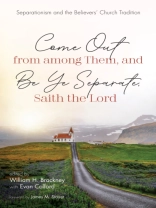Believers’ Churches have their origin in the Radical Reformation of the sixteenth century. Over the past 450 years the movement has included the Brethren, Mennonites, Hutterites, various types of Baptists, and the Restoration Movement. While never a unified denominational structure, the Believers’ Churches together have been characterized by a strong personal faith in Christ, a call to discipleship and Christian activism, a high view of the authority of Scripture, and profession of faith in believers’ baptism. The Believers’ Churches have represented their beliefs in various ecumenical settings, missionary gatherings, and theological conversations.
In the late 1950s, representatives of the several Believers’ Churches began to meet in a series of conferences to explore their common views on doctrine, history, and ethics. Topics at the conferences have included baptism, Lord’s Supper, the nature of the church, and religious voluntarism.
In 2016, the 17th Believers’ Church Conference was held at Acadia University and sponsored by Acadia Divinity College. The theme was 'The Tendency Toward Separationism Among the Believers’ Churches, ’ a key recurring characteristic. This volume includes the papers presented at the conference and examines the theme from an immediate post-Reformation perspective, including Baptists, Black Baptists, Restorationists (including the Churches of Christ), the Hutterites, Pentecostals, the role of women, and significantly, the separationist tendency as it occurs in New Religious Movements. Typologies and analyses are provided by leading historians, theologians, and social science specialists.
O autorze
James M. Stayer is emeritus professor at Queen’s University, Kingston, Ontario. He is a historian of sixteenth-century Anabaptism. Besides Anabaptists and the Sword (1972; revised edn. 1976), he is author of The German Peasants’ War and Anabaptist Community of Goods (1991) and Martin Luther: German Saviour, Evangelical Theological Factions and the Interpretation of Luther, 1917-1933 (2000).







![Pokrywa Brian Schrag & Julisa Rowe: Community Arts for God's Purposes [Chinese] 貼近神心意的社群藝術 Pokrywa Brian Schrag & Julisa Rowe: Community Arts for God's Purposes [Chinese] 貼近神心意的社群藝術](https://static.worldofdigitals.com/thumb_webp/740/9781645083740.webp)




